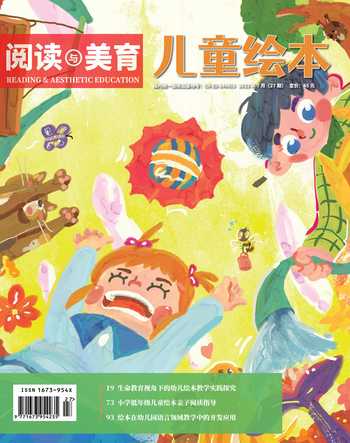“行知”思想入“双减”,浅议乡村小学英语绘本阅读课有效性的提升
黄娅菲
导读:2021年暑假,我国开启了“双减”政策,旨在有效减轻义务教育阶段学生过重的作业负担和校外培训负担,一大重点在于有效提高课堂教学质量。英语是一门语言学科,需要大量输入才会生成高质量的输出。笔者是一名奋斗在一線的乡村英语教师,在教学实践中发现,乡村小学的学生除了在英语课堂上学习英语,在课外主动接触英语的机会很少。乡村小学的部分家长有的常年在外打工顾不到学生的学习,有的文化程度不高,无法指导学生的英语学习,导致学生英语语言知识储备严重不足。所以,学校的英语绘本阅读课对乡村学生来说就显得尤为重要。
目前,笔者所在城市为以一年级为英语学习起点升上来的学生加入了一套英语阅读教材,而以三年级为英语学习起点升上来的学生可以自由选择绘本阅读。但在教学实践中发现,乡村小学英语绘本阅读课的有效性有待提升。究其原因,一方面,乡村小学生的语言储备知识较少,教师会花费大量时间处理绘本中的生词,学生只能理解文本的表面意思,课堂浮于表面。另一方面,教师对课型的定位不准,容易满堂灌输知识,期望在一节课中实现所有教学目标。这导致深层次教学活动形同虚设、浅尝辄止,课堂上的分享展示不充分,学生阅读主观能动性没有得到充分发挥,绘本阅读课的有效性不高。如何在一节乡村小学的英语绘本阅读课中充分调动学生阅读的主观能动性,提升课堂有效性?人民教育家陶行知先生的“六大解放”教育思想给了我们灵感。我们可以解放学生的眼睛、头脑、双手、嘴、空间和时间,进一步提升课堂教学质量,真正让英语课堂服务于“双减”政策的开展。接下来,笔者以《跟上兔子》分级英语绘本四年级上册Can I Play with You?教学设计为例,浅议如何在“六大解放”理论的指导下,提升乡村小学英语绘本阅读课的有效性。
一、多种形式导入,多角度激活学生思维
(一)旧知导新知,解放学生的课堂时间和空间
笔者在热身环节让学生站起来带着动作唱“Don't talk,Tom!”,这首歌是三年级下册学习的内容。在复习歌曲的过程中既激活了课堂氛围,又复习巩固了“want to”这一短语。这种用旧知导入新知的教学方式既解放了学生课堂上的时间和空间,又降低了学生学习新知的难度。
教学片段:
Step 1 Pre-reading
1.Sing a song
T:Hello,boys and girls! Don't talk! Let's begin our class! First,Let's sing a song!
(学生站起来带着动作唱。)
T:Are you happy? I'm happy too. I want to play a game. Can you play with me?
S:Yes?
(二)游戏中的头脑风暴,解放学生的大脑和嘴
头脑风暴是一个很常见的课堂热身环节,可以很好地激活学生的思维,让学生对本节课的学习有一个更好的思维准备。将头脑风暴和游戏相结合既解放了学生的大脑,激活了学生的思维,又激发了学生的学习兴趣,让学生产生表达欲望,解放了学生的嘴。所以,在本节绘本课中,笔者设计扫雷游戏让学生在一个个悬念中选择单词进行句型操练并得到奖励,激发学生学习英语的兴趣,活跃课堂氛围。同时,此处操练的句型均是四年级已学的三个单元的句型,学生易于进入英语学习氛围,掌握相关知识。此处讨论的单词均为动物类单词,与绘本故事的背景相呼应。在讨论动物的过程中渗透课文中的生词rude、polite,让学生根据图片理解含义,降低后面理解文本的难度。此外,由扫雷游戏引出elephant一词,自然过渡到绘本封面,和学生一起讨论绘本主人公little elephant,让学生不知不觉带着好奇进入绘本阅读。
教学片段:
2.Play a game
T:There are two mines under these words. You can choose a word and read it. Then,you can open it. If there is a number under it,you can get some stickers. If there is a mine under it,you get nothing.
T:Let's play! Ready go! Which one do you choose?
S:Dog!
T:Do you have any dogs?
S:Yes,I do.
T:How many dogs do you have?
S:I have two dogs.
T:Great! Now,you can open it! The magic words?
S:Open,open,open!
(随着学生的咒语,点击“dog”一词,出现数字“3”。)
T:Oh! You can get three stickers. Here you are!
S:Thank you!
T:Look! The dog is fighting with the chicken. Do you like this dog?
S:No,I don't.
T:I don't like it,too. Is it rude? Read it after me! “Rude!”
(学生跟读。)
T:And what's behind the smiling face?
T:Lets open it!
S:Its an elephant!
(出示绘本的封面,引导学生讨论绘本封面。)
T:Do you like the elephant? Why?
S:Yes,I do./ No,I don't. It is...
T:Anyway,someone likes it,and someone doesn't. Today,we will read a story about the elephant.Its title is“Can I Play with You?”Read it after me please.
二、帶着问题梳理文本,对比阅读中解放学生的眼睛和头脑
针对一本绘本的阅读,可以按部就班地按顺序浏览,也可以不走寻常路。本课中,笔者以哭声导入故事,先给出故事的开头和中间的转折点,解放学生的眼睛,激发学生的阅读好奇心,引导学生带着疑问阅读前半部分。同时,通过四个问题“小象想要和哪些动物一起玩?”“这些动物在哪里?”“小象和这些动物一起玩什么?”“小象一开始是如何和这些动物一起玩的?”逐步梳理故事,找到小象没有朋友的原因。此时,再回到转折点“I have no friends. I want to play with you,but I don't know how”,围绕“But I don't know how”引导学生阅读后半部分,了解其他动物对小象的建议,找出小象如何有礼貌地和其他动物一起玩。最后,将小象的结局“I have many friends now”和中间部分的情节“I have no friends”作对比,教育学生要礼貌待人,解放学生的头脑。
教学片段:
Step 2 While reading
享受阅读第1步:带着想象走近故事。
T:Listen!(幻灯片播放哭的声音) What's wrong with the little elephant? Let's read the story together. Ok?(幻灯片播放绘本,教师朗读绘本。)
T:Little elephant is naughty. He wants to play with other animals.
T:Oh! No! The page is missing. The page is missing too. And this page is missing.
(幻灯片播放的绘本缺了几页。)
T:Now,little elephant says,“I have no friends. I want to play with you, but I don't know how.”
享受阅读第2步:带着好奇走近故事。
T:Why does the elephant have no friend? Can you guess? Lets learn more about the story.
享受阅读第3步:带着问题理解绘本内容。
(1)Look and find
T:Please open your picture book,and read it by yourself and find out“What animals does little elephant want to play with?”Then put the correct pictures on the blackboard.
(2)Ask and answer
T:We know that the little elephant wants to play with the monkeys.
T:Look! Where are the monkeys?
S:They are in the tree.
T:Good! So we can say,“Little monkey,in the tree.”Read it in the correct rhyme!
(根据绘本内容改编四年级第一单元Rhyme time板块:“Little monkey,in the tree;Little duck,in the water;Little tiger,on the swing;Little elephant,want to play.”在朗读过程中复习巩固新授短语。)
(3)Read and complete
T:Little elephant,want to play. What does little elephant want to play? Open the picture book,read it again,then find out the answer.
T:OK! Now let's check the answer. What does little elephant want to play?
S:He wants to play ball games.
(4)Let's think
T:Are these monkeys happy?
S:No!
T:How do these monkeys feel?
S:Angry.
T:So these monkeys say,“What are you doing,little elephant? Go away!”Read it after me.
T:Then little elephant leaves sadly.Do you like this elephant?
S:No.
T:Why does little elephant have no friends?
T:So the little elephant says,“I'm sorry for my rudeness.” What does rudeness mean? Guess!
(5)Listen and answer
T:Little elephant has no friends. He still wants to play with other animals,but he don't know how. His friends give him some suggestions.Listen!
T:Now Let's check the answer! How does the little elepanant play with other animals politely?
T:Now,the little elephant is polite and do you like it?
S:Yes!
T:We all should be polite. The good meal not late,good words too slow.
三、适度拓展延伸,解放学生双手,高效且减负
本课定位为绘本阅读的第一课时,重在引导学生欣赏和了解绘本故事大意,过度拓展延伸不符合乡村学生的学情,教师教得累,学生也学得云里雾里。所以,本课时的拓展延伸部分,笔者带着学生聆听整体故事而非朗读全文,引导学生带着已有的理解从全局掌握故事内容,真正欣赏故事。同时,这篇故事句型简单且趣味性浓,笔者引导学生根据板书内容,演一演故事最主要的三个场景。其中,板书内容可以帮助学生理清脉络,脱离绘本复述故事。这样既巩固了阅读知识,又提高了学生语言能力。课后,笔者让学生解放双手,制作自己的读书推荐卡,和朋友分享所学的故事,既培养了学生之间的友谊,又在课外对本次阅读课的内容进行了巩固提升,还避免了机械抄写作业,减轻了学生的作业负担。
教学片段:
Step 3 Post-reading
享受閱读第4步:带着期待聆听故事。
享受阅读第5步:有感情地演绎故事。
T:I know that you all like the story.Let's act it out! OK?
S:OK!
T:There are three scenes.You can choose one to act it out.
享受阅读第6步:带着欣赏与他人分享。
T:We should share good things.Now,your homework is making a recommendation card.
四、结语
总之,在“双减”政策背景下,要想有效提升乡村小学英语绘本阅读课的教学质量,我们可以精准提炼问题,让学生带着问题梳理文本,在对比阅读中解放眼睛和头脑。我们也可以适度拓展延伸,解放学生双手,让学生在亲手实践中升华绘本主题。

